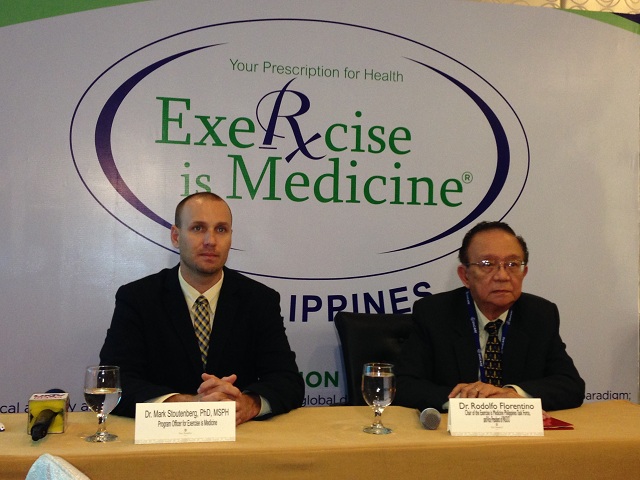Filtered By: Lifestyle
Lifestyle
Exercise should be part of treatment, disease prevention – experts
Text and photo by IBARRA C. MATEO
Appropriate exercise and suitable physical activities performed under the guidance of medical, health, and exercise professionals should be recognized and prescribed as a “medicine” and should be included by healthcare providers in the standard menu of options for the prevention, treatment, and management of certain diseases, health experts said at a forum last month.

Dr. Mark Stoutenberg and Dr. Rodolfo Florentino field questions from reporters during the press conference.
“This is our gospel: physical activity is integral to the prevention and treatment of disease. Exercise should be a standard inclusion in all activities related to disease prevention and treatment,” Florentino said in an interview on the sidelines of the PASOO 2014 annual convention, with the theme “obesity: problems, prospects, and progress.”
Florentino said there are many exercise specialists in the Philippines, but they are “not linked properly” with the medical and health professionals. “These exercise specialists work independently.”
“What we want to do is to establish more ties and strengthen links between exercise specialists and medical and health professionals. We want operational links forged so medical doctors and other health professionals can easily refer patients to exercise specialists,” he added.
Florentino said they are working on training more exercise specialists and medical and health professionals jointly and together to facilitate referrals of patients and to establish working relationships and to build trust and confidence.
Behavior change
Meanwhile, Dr. Mark Stoutenberg, an EIM program officer in the American College of Sports Medicine and an assistant professor in the Department of Public Health Sciences - University of Miami, said EIM advocates want the exercise specialists to learn more about changing the health behaviors of patients.
“What we want to teach the exercise specialists is not about fitness stuff. They know these things. What we want to teach them is health behavior change. Like what patients must do or should do when the exercise specialists are not around them,” Stoutenberg told reporters.
“We want the exercise specialists to be able to teach their patients skills such as goal-setting, overcoming barriers, doing things on their own,” he added.
Stoutenberg said exercise specialists must also recognize the importance of updating with regular progress reports the medical and health professional who referred patients to them.
“The medical and health professionals must be informed regularly of the activities being done by their referred patients and their status. Are they correct and proper activities? Are they safe activities? These are the skills needed to be learned by exercise specialists who are working with high-risk populations,” he added.
Working together
On the part of the medical and health professionals, Stoutenberg said EIM wants to teach them on how to work with exercise specialists.
Stoutenberg said tension arises when professionals who do not know each other must refer patients to each other. “There is the element of how a medical doctor can entrust a patient to an exercise specialist.”
A medical doctor may have reservations referring a patient to an exercise specialist, he added. “We need to get everybody on board on EIM programs.”
EIM is a global initiative to establish physical activity as a standard in health care and aims to push doctors to prescribe exercise as “medicine” based on evidence-based strategies. It was launched in November 2007 by the American College of Sports Medicine and the American Medical Association. It is now present in 40 countries.
Among the goals of the EIM is "transformational change": to institutionalize physical activity assessment and prescription into global health care systems.
EIM Philippines, launched on Sept. 7, 2013 and led by PASOO, is a coalition of health organizations, government agencies and institutions, non-government organizations, and private companies.
In the Philippines, statistics from the 2013 Food and Nutrition Research Institute (FNRI) survey show that an alarming 31.1 percent of adults are either overweight or obese, compared to the 16.6 percent in 1993.
The World Health Organization (WHO) Global Non-Communicable Disease Action Plan 2013- 2020, released in July 2014, said the Philippines has an estimated 571,000 deaths caused by non-communicable diseases. The figure is about 67 percent of the total deaths in 2013, or a 6 percent increase from the data in the 2010 NCD Country Profile.
150 minutes a week
Florentino cited studies showing that 150 minutes per week of moderate physical activity can have “a huge impact on one’s quality of life.”
“At the correct intensity and duration, exercise not only improves the quality of life but also decreases the incidence of diseases, chronic health conditions, and obesity,” he added.
The WHO recommends that adults aged 18–64 should engage in physical activities—“leisure time physical activities” such as walking, dancing, gardening, hiking, and swimming; “transportation” such as walking or cycling; and “occupational” or work-related such as household chores, play, games, sports, or planned exercise in the context of daily, family, and community activities.
In order to improve cardio-respiratory and muscular fitness, bone health, and reduce the risk of NCDs and depression, the WHO said adults aged 18–64 should do at least 150 minutes of moderate-intensity aerobic physical activity throughout the week or at least 75 minutes of vigorous-intensity aerobic physical activity throughout the week or an equivalent combination of moderate- and vigorous-intensity activity.
Aerobic activity should be performed in bouts of at least 10 minutes duration, the organization added.
For additional health benefits, adults should increase their moderate-intensity aerobic physical activity to 300 minutes per week, or engage in 150 minutes of vigorous-intensity aerobic physical activity per week, or an equivalent combination of moderate- and vigorous-intensity activity, the WHO recommended. — BM, GMA News
Tags: fitness
More Videos
Most Popular



